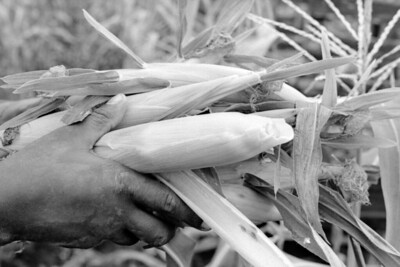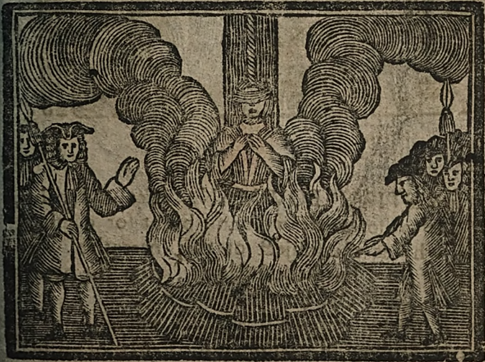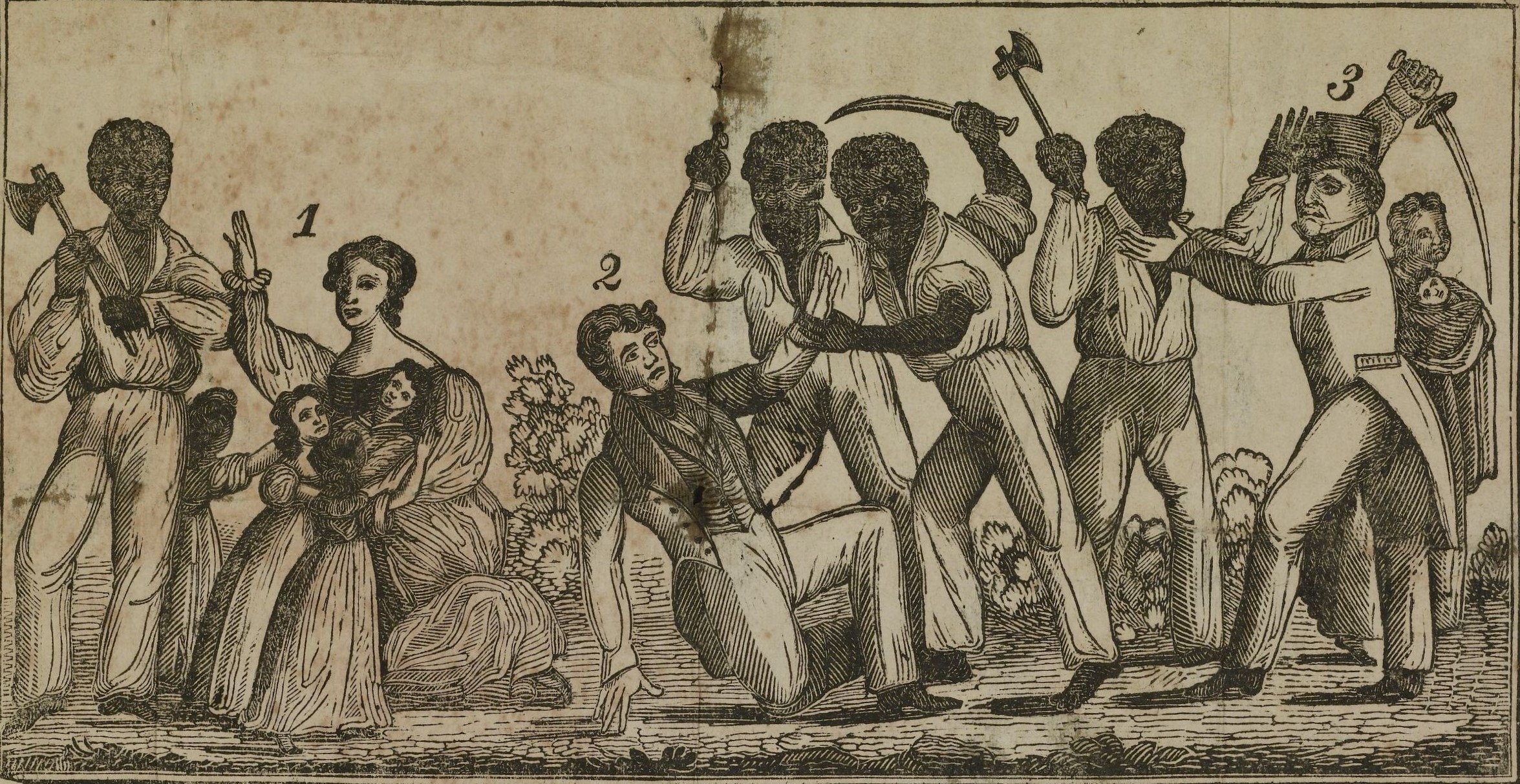Running away was not the only way that enslaved people exerted their own autonomy. Within the confines of bondage, some enslaved people used violence, rebelling against the rules enslavers had set for them and their bodies. For some, violence was a means towards achieving eventual freedom. For others, it was a means of expressing themselves and asserting their own control over the world around them, no matter the consequences.
Engraving of a group of African American men watching as two white people sleep in a burning building. Courtesy of New York Public Library.
Some enslaved people used violence as a means of revenge against their enslavers.
While sometimes a means to freedom, enslaved people also engaged in violence when they’d had enough of the cruel circumstances of their enslavement and desired revenge. One such woman who’d had enough was Rose, an African American woman in Halifax County. Rose was enslaved by Matthew Rabun and when Rabun’s neighbor had Rose whipped for an unspecified crime, Rose immediately desired retribution.
Tired of the cruel treatment she had endured, a short time later when Rabun threatened to burn all of Rose’s clothes, she hit her breaking point. Rose ran away, or self-emancipated herself, and set fire to the neighbor’s barn before making her escape. Later, officials captured Rose, who confessed to the crime. At Rose’s trial, enslaved people testified that she’d told them of her plans to burn area enslavers’ “houses over their heads,” and that if she could not escape, she’d commit suicide. Ultimately the local court found Rose guilty and ordered her execution.
Rose committed these violent acts against her enslaver, knowing fully what the consequences could be. In the face of such severe mistreatment, Rose and other enslaved individuals responded with violence, wanting to exert their own control over themselves and their surroundings, no matter the cost.
Rose used dried ears of corn and corn stalks, pictured here, to fuel the fire she set in John Bradford's barn. Courtesy of the State Archives of North Carolina.
Out of desperation, some enslaved people murdered their enslavers, knowing full well what the consequences would be.
When a chance at freedom was no longer an option, some enslaved individuals banded together to conspire against their enslaver instead. Such was the case for five enslaved people owned by Beaufort County bachelor Henry Ormond. One night in July 1770, one of the enslaved people escaped, but Ormond recaptured them, punishing them severely.
The enslaved escapee was probably Annis, an African American woman responsible for the day-to-day management of Ormond’s household. Feeling as though there was no way out from Ormond’s cruel treatment, Annis then conspired with her fellow enslaved people to hatch a new plan. If they could not leave Ormond’s bondage, then they’d make Ormond’s power over them terminate in another way—by murdering him.
That same night, five of Ormond’s enslaved people, namely Annis, Lucy, Phillis, Cuff, and an unnamed man, crept into Ormond’s bedroom while he was sleeping. Using a handkerchief, they strangled him until he was unresponsive. Ormond regained consciousness however, and when they heard him stir, Annis encouraged the others to return and attack him again. Reportedly Ormond begged for mercy, which Annis refused, citing his prior cruel behavior. The conspirators then placed a spare mattress on top of Ormond, smothering him to death. Trying to cover up their crime, they dressed Ormond in riding clothes, put his body on his horse, and set the horse down the road, hoping to make it seem as if Ormond had died during a nighttime horse-riding accident instead.
During colonial times, the punishment of being burned at the stake was reserved for especially heinous crimes, such as treason. Murdering one's superior was considered petty treason, and, as such, Lucy and the other enslaved people that murdered Ormond faced the fire as punishment. Courtesy of British Library.
Their subterfuge was soon discovered however when the unnamed enslaved man confessed, testifying against the others in exchange for immunity. Annis, Lucy, Phillis, and Cuff were found guilty of the crime and sentenced to death. The others faced the gallows, but for orchestrating the murder, Annis would be burned at the stake. According to oral tradition, Annis did not regret her crime even as the fire started. Ormond had never granted mercy, and therefore she refused to show remorse in return.1 While extreme, Annis’ case demonstrates how desperate enslaved individuals were to improve their circumstances, no matter the risks or consequences.
Not all enslaved violence was local or personal in nature. Mass revolts, though less common, were also a form of enslaved resistance.
During the colonial and revolutionary eras, there was perhaps nothing white North Carolinians feared more than the thought of an enslaved rebellion. During the summer of 1775, those fears became a reality when a group of enslaved people in Pitt, Craven, and Beaufort Counties left their plantations and potentially laid plans for a violent revolt.
According to rumor, Merrick, an enslaved ship’s pilot, had orchestrated the rebellion with assistance from an English ship captain. At least forty people of color were arrested in connection to the plot, and enslavers estimated at up to 250 enslaved people were involved. However, extant records suggest this number was more reflective of enslavers’ paranoia than reality.
Allegedly, the plan for the rebellion was one specific night, enslaved people would kill their masters’ entire families before burning down every enslaver’s home in the area. Once all the enslavers were dead, local African Americans would be free to establish their own independent government, and each person would “take Choice of the Plantation” properties as suited them.
It's difficult to say what the true extent of the plot was, but it’s clear that some enslaved individuals did self-emancipate during this period. Fewer assaulted their enslavers, and it is unclear which white people died as result of the event, if any. Nevertheless, the punishment for this supposed rebellion was harsh. Officials restricted enslaved people’s travel, and any spotted along the region’s roads without permission were legally allowed to be shot as criminals. Because of the attempted uprising, at least six enslaved African American men and women were severely punished. Enslaved revolts, while largely unsuccessful, demonstrated the extent to which enslaved people would fight to achieve their independence.
This engraving depicting Nat Turner's Rebellion in 1831 reveals some enslavers' greatest fears: a violent enslaved uprising. While there appear to have been no white victims of the supposed Pitt and Beaufort enslaved uprising of 1775, unfounded rumors of such violence circled throughtout North Carolina that summer. Courtesy of University of Virginia Library.
- Nikki M. Taylor, “Annis, Phillis, and Lucy: ‘[Your] Begging Is in Vain,’” in Brooding over Bloody Revenge: Enslaved Women’s Lethal Resistance (Cambridge: Cambridge University Press, 2023) 52–65.
- For more information on the omnipresent fear of enslaved revolts and conspiracies in early America, see Jason T. Sharples, The World That Fear Made: Salve Revolts and Conspiracy Scares in Early America (Philadelphia: University of Pennsylvania Press, 2020); Jeffery Crow, “Slave Rebelliousness and Social Conflict in North Carolina, 1775 to 1802,” William and Mary Quarterly 37:1 (Jan., 1980) 79-102; Alan D. Watson, “Impulse Toward Independence: Resistance and Rebellion Among North Carolina Slaves, 1750-1775,” Journal of Negro 63:4 (Oct., 1978) 317-328; Woody Holton, Forced Founders: Indians, Debtors, Slaves, & the Making of the American Revolution in Virginia (Chapel Hill, University of North Carolina Press, 1999).




